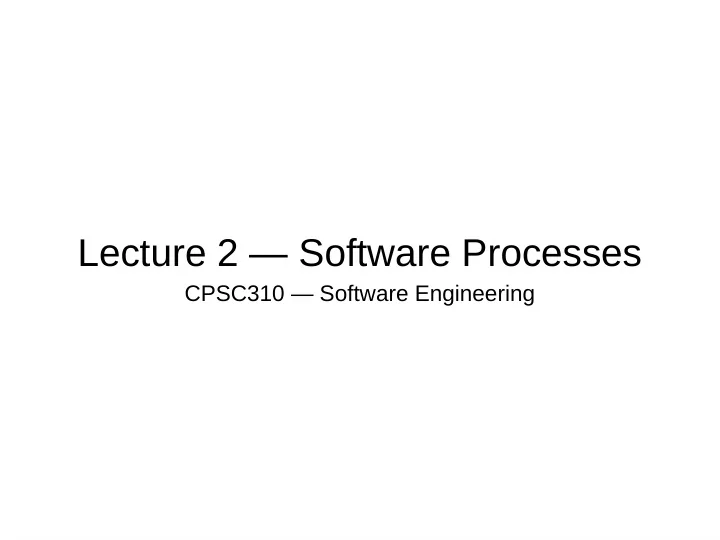

Lecture 2 — Software Processes CPSC310 — Software Engineering
Admin • Finding the syllabus web page (refresh problem in Google) • Group for the project must be formed within the same lab • There is time, you don't need a group for the first 2 labs • Switching between labs should be exceptional (contact the TA in charge of the destination lab) • Wait-list, we'll know by the 16 September • I do not have access to the rankings so far • I do not know how many persons might be able to get in • Contact undergrad-info@cs.ubc.ca for specific cases • Labs are starting next week
Learning Goals
Why do software projects fail? • Unrealistic project goals • Inaccurate estimates of needed resources • Unmanaged risks • Poor communication • … so many reasons!!!
When things go wrong… Denver Baggage (mis)Handling detailed report: http://calleam.com/WTPF/wp-content/uploads/articles/DIABaggage.pdf
Denver Baggage (mis)Handling summary: http://calleam.com/WTPF/?page_id=2086 Underestimation of complexity . Complex architecture . Changes in requirements . Underestimation of schedule and budget. Dismissal of advice from experts. Failure to build in backup or recovery process to handle situations in which part of the system failed. The tendency of the system to enjoy eating people’s baggage .
The Beginning… risk flagged; ignored. scale changed risks flagged; ignored hasty contract requirements change requirements change guru dies
…The End requirements change delays technical challenges more delays BAE blames the user manual system used instead BAE fined for overtime done! but badly/partly scrapped
So what happened? • bad planning: They left it late! The software production started only 17 months before the scheduled opening • In Munich, engineers spent two years testing a similar but much smaller system. And even that system is not glitch free (nothing ever is - but at least it’s 24/7 operational) • physical problems: Most buildings were built before the baggage system was designed, meaning the baggage system had to adapt to an architecture that wasn’t a good fit (sharp turns, narrow corridors) • change of management: Death of the driving force of the project (you’d think this was atypical, but gurus often leave a company mid-way through a project, leaving the project somewhat stranded if planning isn’t good) • accepting changing requirements: alterations to baggage sizes, types, paths, etc — and the contractor said a firm “yes” to all these changes! • lack of experience: this was the first time BAE had built a system like this. But for some reason they didn’t choose to ask for outside advice from the Munich baggage system engineers who might have provided insights and helped mitigate risk.
Software Project Risks http://www.iaeng.org/publication/IMECS2011/IMECS2011_pp732-737.pdf • 6 dimensions of risks: • USER: resistance to change; conflicts between them; negative attitudes towards the project; lack of commitment; lack of cooperation • REQUIREMENTS: continually changing; inadequately identified; unclear; incorrect • PROJECT COMPLEXITY: new technology; high technical complexity; immature technology; first use of technology • PLANNING & CONTROL: poor process oversight; inadequate estimation resources; poor planning; unclear milestones; inexperienced pm’s; ineffective communication • TEAM: lack of experience; lack of training; lack of specialized skill • ORGANIZATIONAL ENVIRONMENT: change of management during the project; unstable organization; ongoing restructuring
Projects need a good plan
Software Process • Processes have descriptions that discuss • Products (the outcome of a process activity) • Stakeholders (people who care about the outcome) • (managers, developers, customers, testers)
Software process • Many different software process • All include: • requirements elicitation • architectural design • detailed design • implementation • integration the goal for each of these activities is to: • testing - mark out a clear set of steps - produce tangible item(s) - allow for review of work - specify actions to perform next
Is Process Worth It? http://www.stevemcconnell.com/articles/art09.htm Process-Oriented Team Process Phobic Team “During the first few weeks of the “When a project has paid too little project, the process-oriented team will early attention to the processes it will seem less productive than the use, by the end of a project process-phobic team… By the end of developers feel they are spending all the project, the process-oriented team of their time in meetings and will be operating at a high-speed hum, correcting defects and little or no time with little thrashing, and performing its extending the software.” processes with little conscious effort.”
Software Process Models Some models are better for Project leads need to be some types of projects than able to choose and tailor a others. Often models are model and assess risk combined to build a tailored Developers need to process for building a certain understand processes and type of product. work within them
Waterfall Model (this picture looks old, because this process is old!) Royce, 1970 http://www.cs.umd.edu/class/spring2003/cmsc838p/Process/waterfall.pdf AKA: Big Design Up Front
Waterfall Model AKA: Big Design Up Front Benefits:
Waterfall Model AKA: Big Design Up Front Drawbacks:
V Model Waterfall “extension” Operation Concept of and Verification Operations Maintenance and Validation Project System Requirements Definition Verification and and Validation Architecture Integration, Project Detailed Test, and Test and Design Verification Integration Implementation Implementation Time "Systems Engineering Process II" by Leon Osborne, Jeffrey Brummond, Robert Hart, Mohsen (Moe) Zarean Ph.D., P.E, Steven Conger
Spiral Model Boehm B, "A Spiral Model of Software Development and Enhancement", ACM SIGSOFT Software Engineering Notes", "ACM", 11(4):14-24, August 1986
Spiral Model Benefits: Drawbacks: Manages risk by repeated prototyping High administrative overhead Requirements changes incorporated Can be overly conservative if you have iteratively high confidence in the project outcome
Agile Models/Principles
Flavours of Agile…
Flavours of Agile…
Summary More on Agile… We will be getting more into agile principles and models in the next lecture…
Recommend
More recommend